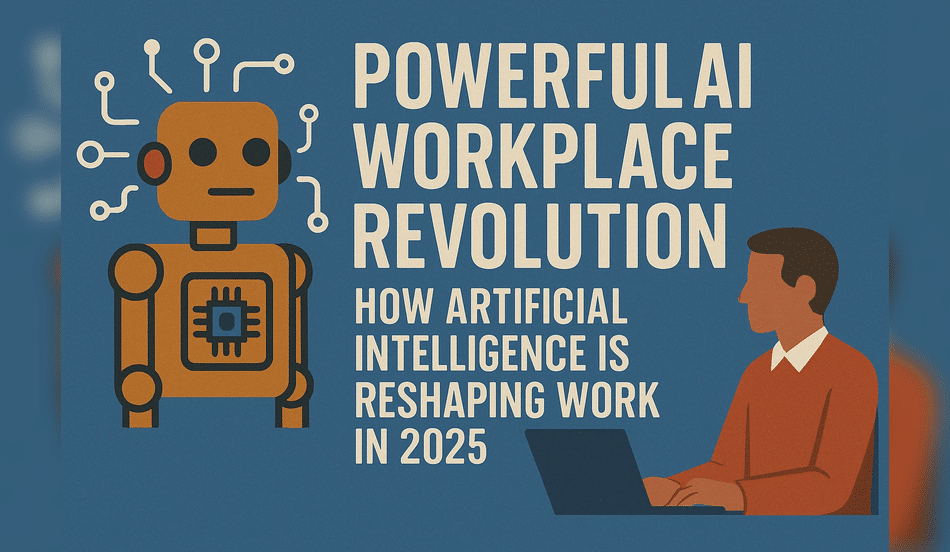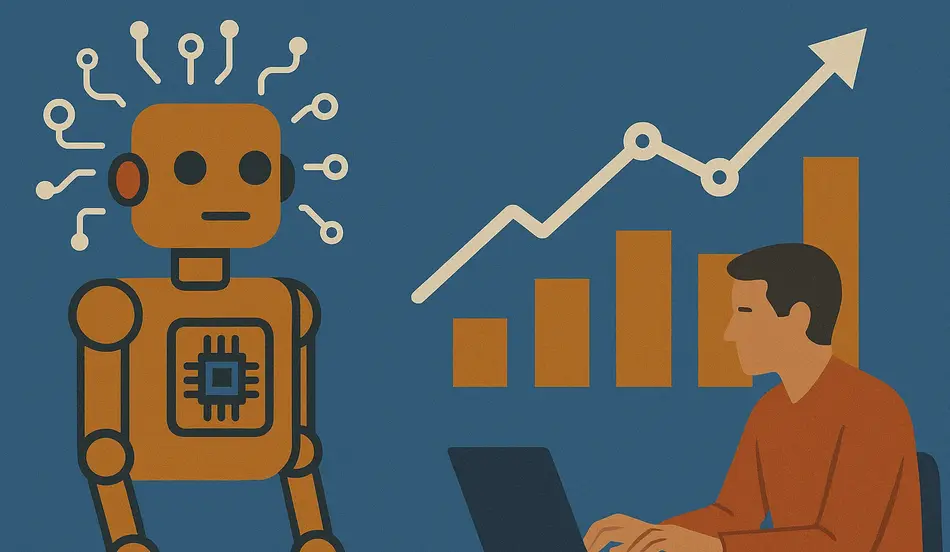Artificial intelligence job impact 2025 is at the center of today’s workplace transformation. AI is rapidly reshaping how companies operate, raising critical questions about job security, workforce productivity, and the future of employment itself. While many organizations are eager to integrate AI into daily workflows, a gap remains: nearly two-thirds of desk workers still haven’t adopted the technology.
This comprehensive exploration examines the artificial intelligence job impact in 2025, revealing how the workplace is evolving, what challenges remain in implementation, and what leaders must know to manage this powerful technological shift effectively.
AI Adoption Faces a Critical Disconnect Between Leadership and Employees
The gap between executive expectations and employee behavior regarding AI adoption presents one of the most significant challenges in today’s workplace. Research from Salesforce’s Slack Workforce Lab reveals a striking contrast: executive urgency to incorporate AI has increased sevenfold over just six months, making it the top priority for business leaders worldwide.
However, despite this push from the top, approximately two-thirds of desk workers still aren’t utilizing AI technologies in their daily work. This disconnect highlights the complex human factors at play in the AI workplace revolution.
“What we see in the data is that the executive urgency to incorporate AI is at an all-time high,” explains Christina Janza, head of Slack Workforce Lab and SVP of research and analytics. “But what’s really interesting is two-thirds of our desk worker population are still not using this technology.”
This disparity creates a situation where, as one industry expert colorfully described it, “CEOs have bought Ferraris in the shape of state-of-the-art AI systems, but they haven’t given any driving lessons to their staff.”
Learn more about AI adoption strategies from McKinsey & Company
Understanding the Five AI Workplace Personas
Slack’s research has identified five distinct personas that help explain how different employees approach AI in the workplace:
1. The Maximalist
- Actively uses AI with enthusiasm
- Sees clear benefits and applications
- Serves as an internal advocate for AI adoption
- Embraces new AI tools and features
2. The Underground
- Uses AI extensively but hides their usage
- Feels guilty about AI utilization
- Fears being perceived as “cheating”
- Benefits from AI but keeps it private
3. The Rebel
- Views AI as a potential threat
- Actively resists adoption
- May have concerns about job security
- Questions the ethics or reliability of AI
4. The Super Fan
- Excited about AI’s potential
- Lacks knowledge on how to start using it
- Enthusiastic but inactive
- Needs guidance and training
5. The Observer
- Takes a “wait and see” approach
- Shows moderate interest and caution
- Not actively engaged with AI
- Waiting for more evidence of benefits
This diversity of attitudes explains why blanket AI implementation strategies often fail. Organizations must recognize and address the needs and concerns of each persona type to drive successful adoption in the ongoing AI workplace revolution.
Explore how AI is changing job requirements on WhatJobs

Trust: The Missing Piece in AI Adoption
Trust emerges as a critical factor in successful AI implementation. Research indicates that only 7% of workers worldwide fully trust AI—a significant barrier to adoption that organizations must address during this AI workplace revolution.
“There is a trust piece missing,” notes Christina Janza. “That’s to be expected with new technology. You have to use it, you have to get used to it in order to really understand whether you can trust it.”
Interestingly, the human element plays a crucial role in building this trust. Employees who feel trusted by their managers are twice as likely to experiment with AI tools. This highlights how interpersonal relationships significantly influence technological adoption.
“So much of the conversation we’re having is around the technology—all of the amazing advances that we’re making, all of the amazing things that this technology can do,” Janza explains. “But you can build the coolest technology in the world, and if people don’t use it, it doesn’t matter.”
Key Trust-Building Factors:
- Clear organizational policies on AI usage
- Transparent communication about AI capabilities and limitations
- Manager-employee relationships built on mutual trust
- Safe spaces to experiment and learn without fear of failure
- Recognition that trust-building takes time and consistent positive experiences
Research shows that when businesses establish defined safe usage guidelines and accommodate different AI personas, employees are nearly six times more likely to use AI tools in the workplace.
Leadership Guidance Gap Creates Uncertainty
Despite the push for AI adoption, many employees are navigating this new territory without proper guidance. A recent survey found that 43% of desk workers have received no direction from their leaders or organization on how to use AI tools at work.
This leadership vacuum creates uncertainty and hesitation among employees. Without clear guidelines on appropriate use cases, data security protocols, and ethical considerations, many workers default to non-adoption or underground usage in the AI workplace revolution.
“Now’s the time to really sit down and figure out what is your policy going to be, what are you going to allow your employees to do, and just be clear,” advises Janza. “The most important thing is transparency.”
Organizations that provide comprehensive guidance on AI usage see significantly higher adoption rates and more positive outcomes from their AI investments.
🤖 Explore AI-Driven Careers on WhatJobs
Worried about the artificial intelligence job impact in 2025?
Discover future-proof opportunities in AI, Data Science, Machine Learning, and Robotics — the roles driving workplace innovation.
WhatJobs helps you stay competitive by connecting you with high-demand tech careers evolving alongside the AI revolution.
👉 Browse top AI and automation jobs now — and build a smarter career path.Experience Matters: The AI Expertise Gap
The effectiveness of AI tools often correlates with a user’s experience level. Research shows that senior employees typically extract more value from AI systems than junior staff—not because of the technology itself, but because of their expertise in task delegation.
“The reason why somebody who’s senior can do better with AI than someone who perhaps is junior is because when you use a generative AI tool, it’s a little bit like delegating tasks,” explains Azeem Azhar, tech investor and founder of Exponential View. “And who best delegates tasks? Well, people who’ve been delegating tasks for 15 or 20 years—that is, the senior executives.”
This creates a potential experience gap where those who might benefit most from AI’s productivity enhancements—junior and mid-level employees—may struggle to effectively utilize the technology without proper training and guidance.
How Organizations Can Bridge the Experience Gap:
- Develop AI training programs tailored to different experience levels
- Create mentorship opportunities between AI-savvy and less experienced staff
- Provide clear examples of effective AI prompts and use cases
- Establish feedback mechanisms to refine AI usage over time
- Recognize that AI proficiency is a learned skill requiring practice
The Promise and Pitfalls of AI Implementation
While AI offers tremendous potential to transform workplaces, organizations must navigate several significant challenges in the AI workplace revolution:
Reliability Concerns
AI technologies remain imperfect and sometimes produce unreliable results. As Azeem Azhar notes, “This is still quite a complicated technology… it can also be a little bit unreliable, and when you have a complicated technology that’s unreliable, you have got to be prepared for things to go a bit askew.”
Cost-Cutting Temptations
There’s a risk that companies will view AI primarily as a cost-cutting tool rather than an enhancement to human capabilities. “One of the things that I urge bosses to do is to be much more circumspect about headcount reductions because you never know exactly where the pieces are going to fall,” cautions Azhar.
Integration Complexity
Despite the consumer-friendly interface of tools like ChatGPT, integrating AI systems with existing enterprise software and workflows presents significant technical challenges.
Data Quality Issues
AI systems are only as good as the data they’re trained on, making data quality and governance critical success factors for implementation.
Read about ethical AI implementation from Harvard Business Review
Real-World AI Applications: Performance Reviews and Meeting Assistance
Companies are finding practical applications for AI that enhance rather than replace human capabilities in the AI workplace revolution:
AI-Enhanced Performance Reviews
HR software company Lattice has integrated AI capabilities that help managers create better performance reviews. The system:
- Analyzes available data and previous feedback
- Learns the manager’s tone and grammar
- Creates authentic performance reviews that maintain the manager’s voice
- Ensures feedback is inclusive, actionable, and concise
“Regardless of what level of experience you have with feedback delivery, it up-levels your writing in a way that converges with best feedback writing practices,” explains a Lattice representative.
AI Meeting Assistants
Executives are using AI assistants to enhance productivity in meetings:
- Detailed transcript creation and summarization
- Performance evaluation and improvement suggestions
- Action item tracking and follow-up
- Meeting preparation and background research
These applications demonstrate how AI can enhance human capabilities rather than replace them, addressing specific pain points in the workplace.
The Future: AI Agents and Autonomous Action
The next frontier in the AI workplace revolution is the development of AI agents—assistants that can perform actions on your behalf rather than simply providing information. These agents will be able to:
- Schedule meetings and coordinate calendars
- Research topics and compile findings
- Draft communications based on context
- Execute routine tasks without human intervention
- Learn from feedback to improve performance over time
This evolution raises important questions about autonomy, accountability, and oversight. As one executive notes, “The questions then are: how are we going to manage it, how are we going to hold it accountable, how are we going to be transparent with decisions that we’re making?”
Organizations will need to develop clear frameworks for when and how AI agents can act autonomously versus when human review is required.
Hiring?
Find AI-Ready Talent to Drive Your Digital Transformation
Post jobs with WhatJobs and connect with candidates who can help your organization navigate the AI workplace revolution.
The Path Forward: Balancing Speed and Caution
As organizations navigate AI implementation, they face a fundamental tension between moving quickly to capture competitive advantages and proceeding cautiously to avoid pitfalls in the AI workplace revolution.
“One could say you move slow to go fast. The other thing is you need to be rapidly experimenting to learn along the way,” advises one AI implementation expert. “What I will go to is the thing that is holding people back from going fast is their data not being in order, integrations not being set up, and people not having understanding for what’s happening.”
This suggests a balanced approach:
- Ensure foundational elements (data, integrations, training) are in place
- Start with small, focused experiments
- Learn and iterate based on results
- Scale successful implementations
- Maintain transparency throughout the process
Need Career Advice?
Get employment skills advice for navigating the AI-transformed workplace by visiting WhatJobs Career Advice
FAQ About AI Workplace Revolution
What is causing the AI workplace revolution in 2025?
The AI workplace revolution is being driven by advances in generative AI technology, particularly since the launch of ChatGPT in late 2022. This powerful AI workplace revolution has made sophisticated AI tools accessible to everyday users through simple conversational interfaces, enabling businesses to streamline processes, enhance productivity, and transform how work gets done across industries.
How are employees responding to the AI workplace revolution?
Employee responses to the AI workplace revolution vary significantly, with research identifying five distinct personas: Maximalists who enthusiastically adopt AI, Underground users who utilize AI but hide it, Rebels who resist adoption, Super Fans who are excited but don’t know how to start, and Observers taking a wait-and-see approach. Only about one-third of desk workers are actively using AI tools despite executive enthusiasm for the AI workplace revolution.
What can business leaders do to improve AI adoption during this workplace revolution?
To improve AI adoption during this workplace revolution, business leaders should establish clear usage guidelines, provide comprehensive training, build trust through transparency, accommodate different AI personas, and recognize that adoption takes time. Research shows employees are nearly six times more likely to use AI tools when organizations have defined safe usage policies and support various learning styles throughout the AI workplace revolution.
How will the AI workplace revolution affect jobs in the coming years?
The AI workplace revolution will transform jobs rather than simply eliminate them, creating new roles focused on AI management, ethics, and implementation while changing how existing positions function. While some routine tasks will be automated, the technology will primarily augment human capabilities, requiring workers to develop new skills in AI collaboration, critical thinking, and creative problem-solving to thrive in the evolving landscape of the AI workplace revolution.




